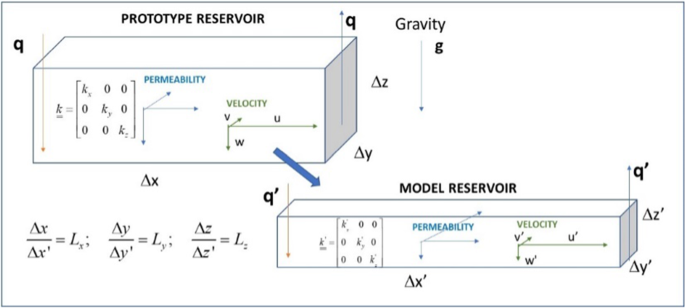非混相粘性指法:润湿性/毛细性和结垢的影响
摘要
真实的非混相粘性指指现象显示了实验中观察到的所有复杂的指指结构,已被证明是非常难以基于多孔介质中两相流方程的直接数值模拟的。最近,作者提出了一种用数值方法求解粘性主导的非混相指法问题的方法。该方法给出了较为真实的复杂非混相指法,与一组粘性不稳定二维水→油驱替实验结果吻合较好。此外,该方法还很好地预测了该体系对三级聚合物注入的响应。在本文中,我们扩展了之前的工作,考虑了润湿性/毛细性对非混相粘性指指的影响,例如在粘度比为\(\left( {\mu_{{\text{o}}} /\mu_{{\text{w}}} } \right) \gg 1\)的水→油驱替中。我们用相应的毛细管压力的形式来识别特定的润湿状态,用于模拟该系统。人们早就知道,毛细作用的广泛作用就像两相流方程中的非线性扩散项,这里用\(D(S_{w} )\)表示。因此,在方程中加入毛细管压力\(P_{c} (S_{w} )\)作为粘指的阻尼或稳定项,其中重要的是该量的导数,即\(D(S_{w} )\sim\left( {dP_{c} (S_{w} )/dS_{w} } \right)\)。如果这种毛细效应足够大,那么我们预计粘性指指将被完全阻尼,线性稳定性理论支持了这一观点。然而,目前还没有令人信服的数值模拟能够清楚地显示不同润湿性系统的这种影响,这首先是由于模拟现实的不混相指指的问题(即对于粘度占主导地位的情况\(P_{c} = 0\))。由于我们已经有了一种很好的方法,可以在数值上生成\(P_{c} = 0\)情况下复杂的现实非混相指指,因此我们能够首次提出一项研究,检查粘性主导的极限和粘性/毛细力平衡的逐渐变化。这种力平衡还取决于系统的物理尺寸以及毛细阻尼的长度尺度。为了解决这些问题,缩放理论被应用,使用Rapport(1955)的经典方法,以系统的方式研究这种缩放。在本文中,我们表明润湿性/毛细性对非混相粘性指指的影响比上面(大致正确的)定性描述更复杂和有趣。从“实验室规模”的二维水→油位移基本情况来看,我们已经用我们的数值方法很好地匹配了明显的不混相粘性指征,我们检查了引入不同“量级”的水湿(WW)或油湿(OW)毛细管压力的影响。这两种情况(WW和OW)的特征对于相应的\(D(S_{w} )\)函数值如何与粘性占主导地位(\(P_{c} = 0\))的(Buckley-Leverett)激波前饱和度\(S_{wf}\)相关联非常重要。通过分析这一点,并进行一些确认计算,我们清楚地说明了为什么我们期望在实验室尺度上在油湿而不是水湿系统中看到更清晰的非混相指动。事实上,我们证明了为什么在WW实验室系统中很难看到不混相指指。根据这一发现,人们可能会得出这样的结论:既然在WW实验室规模的情况下没有观察到指法,那么在更大的“现场”规模上也不会出现指法。然而,通过调用缩放理论——特别是粘性/毛细缩放组\(C_{{{\text{VC1}}}}\)(以及相应的“形状组”\(C_{{{\text{S}}1}}\)),我们非常清楚地证明,尽管WW粘性指通常不会出现在实验室规模上,但当我们以系统的方式“膨胀”系统的尺寸时,它们会非常明显地出现。相比之下,我们确切地证明了为什么在实验室规模下,OW(或弱润湿)情况下更有可能观察到粘性指指。最后,为了证实我们在实验室规模上对WW和OW不混相指法结论的分析,我们在实验室规模的头包中进行了两个实验,其中\(\left( {\mu_{{\text{o}}} /\mu_{{\text{w}}} } \right) = 100\);在WW病例中未见指征,而在OW病例中观察到明显发展的不混相指征。

Realistic immiscible viscous fingering, showing all of the complex finger structure observed in experiments, has proven to be very difficult to model using direct numerical simulation based on the two-phase flow equations in porous media. Recently, a method was proposed by the authors to solve the viscous-dominated immiscible fingering problem numerically. This method gave realistic complex immiscible fingering patterns and showed very good agreement with a set of viscous unstable 2D water → oil displacement experiments. In addition, the method also gave a very good prediction of the response of the system to tertiary polymer injection. In this paper, we extend our previous work by considering the effect of wettability/capillarity on immiscible viscous fingering, e.g. in a water → oil displacements where viscosity ratio \(\left( {\mu_{{\text{o}}} /\mu_{{\text{w}}} } \right) \gg 1\). We identify particular wetting states with the form of the corresponding capillary pressure used to simulate that system. It has long been known that the broad effect of capillarity is to act like a nonlinear diffusion term in the two-phase flow equations, denoted here as \(D(S_{w} )\). Therefore, the addition of capillary pressure, \(P_{c} (S_{w} )\), into the equations acts as a damping or stabilisation term on viscous fingering, where it is the derivative of this quantity that is important, i.e. \(D(S_{w} )\sim\left( {dP_{c} (S_{w} )/dS_{w} } \right)\). If this capillary effect is sufficiently large, then we expect that the viscous fingering to be completely damped, and linear stability theory has supported this view. However, no convincing numerical simulations have been presented showing this effect clearly for systems of different wettability, due to the problem of simulating realistic immiscible fingering in the first place (i.e. for the viscous-dominated case where \(P_{c} = 0\)). Since we already have a good method for numerically generating complex realistic immiscible fingering for the \(P_{c} = 0\) case, we are able for the first time to present a study examining both the viscous-dominated limit and the gradual change in the viscous/capillary force balance. This force balance also depends on the physical size of the system as well as on the length scale of the capillary damping. To address these issues, scaling theory is applied, using the classical approach of Rapport (1955), to study this scaling in a systematic manner. In this paper, we show that the effect of wettability/capillarity on immiscible viscous fingering is somewhat more complex and interesting than the (broadly correct) qualitative description above. From a “lab-scale” base case 2D water → oil displacement showing clear immiscible viscous fingering which we have already matched very well using our numerical method, we examine the effects of introducing either a water wet (WW) or an oil wet (OW) capillary pressure, of different “magnitudes”. The characteristics of these two cases (WW and OW) are important in how the value of corresponding \(D(S_{w} )\) functions, relate to the (Buckley–Leverett) shock front saturation, \(S_{wf}\), of the viscous-dominated (\(P_{c} = 0\)) case. By analysing this, and carrying out some confirming calculations, we show clearly why we expect to see much clearer immiscible fingering at the lab scale in oil wet rather than in water wet systems. Indeed, we demonstrate why it is very difficult to see immiscible fingering in WW lab systems. From this finding, one might conclude that since no fingering is observed for the WW lab-scale case, then none would be expected at the larger “field” scale. However, by invoking scaling theory—specifically the viscous/capillary scaling group, \(C_{{{\text{VC1}}}}\), (and a corresponding “shape group”, \(C_{{{\text{S}}1}}\)), we demonstrate very clearly that, although the WW viscous fingers do not usually appear at the lab scale, they emerge very distinctly as we “inflate” the system in size in a systematic manner. In contrast, we demonstrate exactly why it is much more likely to observe viscous fingering for the OW (or weakly wetting) case at the lab scale. Finally, to confirm our analysis of the WW and OW immiscible fingering conclusions at the lab scale, we present two experiments in a lab-scale bead pack where \(\left( {\mu_{{\text{o}}} /\mu_{{\text{w}}} } \right) = 100\); no fingering is seen in the WW case, whereas clear developed immiscible fingering is observed in the OW case.

 求助内容:
求助内容: 应助结果提醒方式:
应助结果提醒方式:


